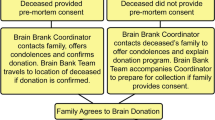Abstract
Advances in cellular and molecular biology underpin most current therapeutic advances in medicine. Such advances for neurological and neurodegenerative diseases are hindered by the lack of similar specimens. It is becoming increasingly evident that greater access to human brain tissue is necessary to understand both the cellular biology of these diseases and their variation. Research in these areas is vital to the development of viable therapeutic options for these currently untreatable diseases. The development and coordination of human brain specimen collection through brain banks is evolving. This perspective article from the Sydney Brain Bank reviews data concerning the best ways to collect and store material for different research purposes.

Similar content being viewed by others
References
Kretzschmar H. Brain banking: opportunities, challenges and meaning for the future. Nat Rev Neurosci 2009, 10: 70–78.
Royal College of Pathologists of Australasia Autopsy Working Group P. The decline of the hospital autopsy: a safety and quality issue for healthcare in Australia. Med J Aust 2004, 180: 281–285.
Vonsattel JP, Del Amaya MP, Keller CE. Twenty-first century brain banking. Processing brains for research: the Columbia University methods. Acta Neuropathol 2008, 115: 509–532.
Klioueva NM, Rademaker MC, Dexter DT, Al-Sarraj S, Seilhean D, Streichenberger N, et al. BrainNet Europe’s Code of Conduct for brain banking. J Neural Transm (Vienna) 2015, 122: 937–940.
The Lancet Neurology. Brain banking: more effective strategies needed. Lancet Neurol 2013, 12: 1035.
Bell JE, Alafuzoff I, Al-Sarraj S, Arzberger T, Bogdanovic N, Budka H, et al. Management of a twenty-first century brain bank: experience in the BrainNet Europe consortium. Acta Neuropathol 2008, 115: 497–507.
Palmer-Aronsten B, Sheedy D, McCrossin T, Kril J. An international survey of brain banking operation and characterization practices. Biopreserv Biobank 2016, 14: 464–469.
Rascovsky K, Hodges JR, Knopman D, Mendez MF, Kramer JH, Neuhaus J, et al. Sensitivity of revised diagnostic criteria for the behavioural variant of frontotemporal dementia. Brain 2011, 134: 2456–2477.
Torrey EF, Webster M, Knable M, Johnston N, Yolken RH. The stanley foundation brain collection and neuropathology consortium. Schizophr Res 2000, 44: 151–155.
Nakamura K, Mori F, Tanji K, Miki Y, Toyoshima Y, Kakita A, et al. α-Synuclein pathology in the cranial and spinal nerves in Lewy body disease. Neuropathology 2016, 36: 262–269.
Klos KJ, Ahlskog JE, Josephs KA, Apaydin H, Parisi JE, Boeve BF, et al. Alpha-synuclein pathology in the spinal cords of neurologically asymptomatic aged individuals. Neurology 2006, 66: 1100–1102.
Vonsattel JP, Aizawa H, Ge P, DiFiglia M, McKee AC, MacDonald M, et al. An improved approach to prepare human brains for research. J Neuropathol Exp Neurol 1995, 54: 42–56.
Ramirez EPC, Keller CE, Vonsattel JP. The New York Brain Bank of Columbia University: practical highlights of 35 years of experience. Handb Clin Neurol 2018, 150: 105–118.
Ervin JF, Heinzen EL, Cronin KD, Goldstein D, Szymanski MH, Burke JR, et al. Postmortem delay has minimal effect on brain RNA integrity. J Neuropathol Exp Neurol 2007, 66: 1093–1099.
Robinson AC, Palmer L, Love S, Hamard M, Esiri M, Ansorge O, et al. Extended post-mortem delay times should not be viewed as a deterrent to the scientific investigation of human brain tissue: a study from the Brains for Dementia Research Network Neuropathology Study Group, UK. Acta Neuropathol 2016, 132: 753–755.
Schmitt A, Bauer M, Heinsen H, Feiden W, Consortium of Brainnet Europe, II, Falkai P, et al. How a neuropsychiatric brain bank should be run: a consensus paper of Brainnet Europe II. J Neural Transm (Vienna) 2007, 114: 527–537.
Nolan M, Troakes C, King A, Bodi I, Al-Sarraj S. Control tissue in brain banking: the importance of thorough neuropathological assessment. J Neural Transm (Vienna) 2015, 122: 949–956.
Tan RH, Yang Y, Halliday GM. Multiple neuronal pathologies are common in young patients with pathologically proven Frontotemporal lobar degeneration. Neuropathol Appl Neurobiol 2017. https://doi.org/10.1111/nan.12455
Hulette CM. Brain banking in the United States. J Neuropathol Exp Neurol 2003, 62: 715–722.
Watson PH, Nussbeck SY, Carter C, O’Donoghue S, Cheah S, Matzke LA, et al. A framework for biobank sustainability. Biopreserv Biobank 2014, 12: 60–68.
Acknowledgements
We wish to thank the employees of the Sydney Brain Bank, and the institutional funding for the facility from the University of New South Wales and Neuroscience Research Australia.
Author information
Authors and Affiliations
Corresponding author
Ethics declarations
Conflict of interest
The authors direct and manage the Sydney Brain Bank.
Rights and permissions
About this article
Cite this article
Shepherd, C.E., Alvendia, H. & Halliday, G.M. Brain Banking for Research into Neurodegenerative Disorders and Ageing. Neurosci. Bull. 35, 283–288 (2019). https://doi.org/10.1007/s12264-018-0326-3
Received:
Accepted:
Published:
Issue Date:
DOI: https://doi.org/10.1007/s12264-018-0326-3




